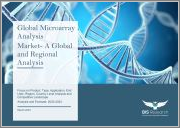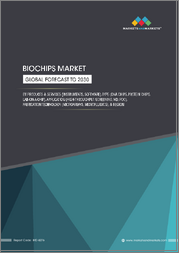
|
시장보고서
상품코드
1455869
마이크로어레이 분석 시장 : 세계 및 지역별 분석 - 제품별, 유형별, 용도별, 최종사용자별, 지역별, 경쟁 환경별 분석 및 예측(2023-2033년)Global Microarray Analysis Market - A Global and Regional Analysis: Focus on Product, Type, Application, End User, Region, Country Level Analysis and Competitive Landscape - Analysis and Forecast, 2023-2033 |
||||||
세계 마이크로어레이 분석 시장 규모는 2023년 53억 5,790만 달러에서 예측 기간 동안 연평균 6.56% 성장하여 2033년에는 101억 1,240만 달러에 달할 것으로 예상됩니다.
이러한 성장은 유전체학 프로젝트 수 증가, 약물 스크리닝에 마이크로어레이 기술 사용, 암 스크리닝에 마이크로어레이 기술 채택 증가 등에 기인합니다. 이 시장에는 다양한 소모품, 장비, 소프트웨어 및 서비스가 포함됩니다.
시장 라이프사이클 단계
| 주요 시장 통계 | |
|---|---|
| 예측 기간 | 2023-2033년 |
| 2023년 평가액 | 53억 5,000만 달러 |
| 2033년 전망 | 101억 1,000만 달러 |
| CAGR | 6.56% |
제품별로는 소모품 부문이 시장을 독점하고 있습니다.
제품별로는 소모품 부문이 2022년 시장을 장악했습니다. 이 카테고리에는 시약, 키트, 어레이 플레이트 등이 포함되며, 이는 마이크로어레이 공정에 필수적이며 시료의 준비, 처리 및 분석을 용이하게 합니다. 이러한 소모품은 일회용이기 때문에 반복적으로 필요하며, 공급업체의 지속적인 수익원이자 연구 및 혁신의 초점이 되고 있습니다. 이러한 소모품의 발전은 마이크로어레이 검사의 효율성, 신뢰성, 처리량을 향상시켜 연구 및 임상 분야 모두에서 채택을 더욱 촉진하는 것을 목표로 합니다. 질병 진단부터 신약 개발까지 다양한 분야에서 매우 중요한 역할을 하는 소모품은 마이크로어레이 기술의 일상적인 운영에 필수적인 요소로, 마이크로어레이 분석 시장에서 우위를 점할 수 있도록 돕습니다.
유형별로는 DNA 마이크로어레이가 시장에서 우위를 점하고 있습니다.
유형별로는 DNA 마이크로어레이 부문이 2022년 가장 큰 점유율을 차지했으며, DNA 마이크로어레이는 유전체학 연구에서의 중요한 역할로 인해 시장에서의 우위를 유지할 것으로 보입니다. 기초 기술로서 DNA 마이크로어레이는 수천 개의 유전자 발현을 동시에 조사할 수 있는 능력을 제공하여 유전자 활성에 대한 종합적인 스냅샷을 제공합니다. 이 능력은 기초 생물학 연구부터 질병 진단 및 맞춤 의료와 같은 응용 분야에 이르기까지 다양한 응용 분야에서 매우 유용하며, 유전적 변이 식별, 의약품 개발 지원, 바이오마커 탐색 가능성 등 DNA 마이크로어레이의 유용성으로 인해 수요가 더욱 증가하고 있습니다. 유전체학의 발전과 질병에 대한 유전적 영향에 대한 관심이 높아짐에 따라, DNA 마이크로어레이는 연구자와 임상의가 선호하는 선택이 되어 시장에서 지속적인 우위를 점하고 있습니다.
세계 마이크로어레이 분석(Microarray Analysis) 시장을 조사했으며, 시장 개요, 주요 동향, 기술 및 특허 분석, 규제 환경, 시장 영향요인 및 시장 기회 분석, 시장 규모 추이 및 예측, 각 부문별/지역별 상세 분석, 경쟁 구도, 주요 기업 프로파일 등의 정보를 전해드립니다.
목차
주요 요약
범위와 정의
제1장 시장
- 동향 : 현재 및 향후 영향 평가
- 주요 동향
- 에코시스템 개요 : 마이크로어레이 분석 시장
- R&D 리뷰
- 특허 출원 동향(국가/기업별)
- 규제 상황
- 주요 세계 이벤트의 영향 분석 : COVID-19
- 가격 분석
- 시장 역학 개요
- 시장 성장 촉진요인
- 시장 성장 억제요인
- 시장 기회
제2장 용도
- 용도 분류
- 용도 개요
- 용도 개요
- 유형 개요
- 최종사용자 개요
- 세계의 마이크로어레이 분석 시장 : 유형별
- DNA 마이크로어레이
- 단백질 마이크로어레이
- 기타
- 세계의 마이크로어레이 분석 시장 : 용도별
- 임상 진단
- Drug Discovery 및 중개연구
- 기타
- 세계의 마이크로어레이 분석 시장 : 최종사용자별
- 제약 기업 및 바이오테크놀러지 기업
- 진단실험실
- 학술기관 및 연구기관
- 기타
제3장 제품
- 제품 분류
- 제품 개요
- 제품
- 시장 개요
- 세계의 마이크로어레이 분석 시장 : 제품 유형별
- 기기
- 소모품
- 소프트웨어 및 서비스
제4장 지역
- 지역 개요
- 성장 촉진요인 및 억제요인
- 북미
- 유럽
- 아시아태평양
- 라틴아메리카
- 중동 및 아프리카
제5장 시장 : 경쟁 벤치마킹 및 기업 개요
- 다음 프론티어
- 경쟁 평가
- Agilent Technologies, Inc.
- Thermo Fisher Scientific, Inc.
- Illumina, Inc.
- Bio-Rad Laboratories, Inc.
- F. Hoffmann-La Roche Ltd.
- Merck KGaA
- Revvity, Inc.(PerkinElmer, Inc.)
- Arrayit Corporation
- Danaher Corporation
- Invitae Corporation
- Helix OpCo LLC
- Applied Microarrays LLC(SCHOTT)
- Microarrays Inc.
- Win Semiconductors Corp.
- Akonni Biosystems, Inc.
제6장 조사 방법
LSH 24.04.23Global Microarray Analysis Market Overview
The global microarray analysis market is projected to experience substantial growth over the forecast period 2023-2033. Moreover, the market value for 2023 was $5,357.9 million and is expected to reach $10,112.4 million by 2023, growing at a CAGR of 6.56% during the forecast period. This growth can be attributed to rising numbers of genomics projects fuelling the growth of microarray analysis market, use of microarray technology in drug screening, increasing adoption of microarray technology in cancer screening. The market includes various consumables, instruments, and software and services.
Market Lifecycle Stage
| KEY MARKET STATISTICS | |
|---|---|
| Forecast Period | 2023 - 2033 |
| 2023 Evaluation | $5.35 Billion |
| 2033 Forecast | $10.11 Billion |
| CAGR | 6.56% |
The microarray analysis market is currently in a mature stage with a robust growth trajectory, propelled by the rising demand for precision medicine and advancements in genetic and genomic research. The market is characterized by a mix of well-established companies and innovative startups, all competing to offer advanced solutions that cater to the evolving demands of research and diagnostics.
Industry Impact
The global microarray analysis market has a significant impact on the biomedical industry, particularly in genomics and personalized medicine. It has become a pivotal tool for scientists and researchers in understanding gene expression and genetic variations, influencing advancements in disease diagnostics and treatment strategies. The technology has been crucial in the development of targeted therapies and the growing field of precision medicine, allowing for more individualized treatment plans based on genetic profiles. Moreover, microarray analysis contributes to the efficiency of drug discovery processes, making it a cornerstone in the pharmacogenomics sector. Despite its profound impact, the market faces challenges due to the high costs of microarray instruments and analysis, which can limit its accessibility.
The global microarray analysis market continues to drive transformative advancements across industries, with far-reaching implications for human health, and environmental sustainability.
Market Segmentation:
Segmentation 1: by Product Type
- Instruments
- Consumables
- Software and Services
Consumables to Dominate the Global Microarray Analysis Market (by Product)
Based on product, the consumables segment dominated the global microarray analysis market in FY2022. This category includes reagents, kits, and array plates, which are integral to the microarray process, facilitating the preparation, processing, and analysis of samples. The recurring need for these consumables due to their single-use nature makes them a continuous source of revenue for suppliers and a focal point for research and innovation. Advances in these consumables aim to increase the efficiency, reliability, and throughput of microarray testing, further driving their adoption in both research and clinical settings. Their pivotal role in a wide array of applications, from disease diagnosis to drug discovery, ensures their dominance in the microarray analysis market as they are essential for the daily operation of microarray technologies.
Segmentation 2: by Type
- DNA Microarray
- Protein Microarray
- Other Microarray
DNA Microarray to Hold its Dominance in the Global Microarray Analysis Market (by Type)
Based on technology, DNA microarray segment accounted for the largest share of the global microarray analysis market in FY2022. DNA microarrays are poised to maintain their dominance in the global microarray analysis market due to their critical role in genomics research. As a cornerstone technology, DNA microarrays offer the ability to simultaneously examine the expression of thousands of genes, thereby providing a comprehensive snapshot of gene activity. This capability is invaluable in a range of applications, from basic biological research to the more applied sectors of disease diagnostics and personalized medicine. The demand for DNA microarrays is further bolstered by their utility in identifying genetic variations, aiding in drug development, and enabling biomarker discovery. With the ongoing advancements in genomics and the increased emphasis on understanding genetic influences on diseases, DNA microarrays continue to be a preferred choice for researchers and clinicians, ensuring their sustained prominence in the market.
Segmentation 3: by Application
- Clinical Diagnostics
- Drug Discovery and Translational Research
- Others
Drug Discovery and Translational Research Procedure to Hold its Dominance in the Global Microarray Analysis Market (by Application)
Based on application, the drug discovery and translational research accounted for the largest share of the global microarray analysis market in FY2022 primarily due mainly due to the increasing prevalence of cancer and the subsequent rise in research activities to understand and combat the disease. Microarray analysis has been crucial in cancer research, aiding in the identification of gene expressions and mutations which are vital for understanding cancer mechanisms and developing effective treatments.
Segmentation 4: by End User
- Pharmaceutical and Biotechnology Companies
- Diagnostic Laboratories
- Academic and Research Institutes
- Others
Academic and Research Institutes to Hold its Dominance in the Global Microarray Analysis Market (by End User)
Based on end user, the academic and research institutes accounted for the largest share of the global microarray analysis market in FY2022 due to their extensive use of microarray analysis in drug discovery, development, and personalized medicine applications.
Segmentation 5: by Region
- North America
- Europe
- Asia-Pacific
- Latin America
- Middle East and Africa
Recent Developments in the Global Microarray Analysis Market
- In January 2024, Thermo Fisher Scientific, Inc. introduced the Axiom PangenomiX Array, its most expansive and culturally diverse array yet which provides enhanced genetic coverage for large-scale disease studies and pharmacogenomic investigations.
- In August 2023, Thermo Fisher Scientific, Inc. launched a novel chromosomal microarray aimed at enhancing productivity, efficiency, and profitability in cytogenetic research laboratories boasting an industry-leading turnaround time of just two days
- In March 2023, Microarrays Inc and Alimetrix were acquired by Spectrum Solutions for expansion of laboratory products and testing capabilities.
Demand - Drivers, Restraints, and Opportunities
Market Demand Drivers:
Rising Numbers of Genomics Projects Fueling the Growth of Microarray Analysis Market: The surge in genomics projects globally is a key driver for the expansion of the microarray analysis market. As researchers and scientists undertake more comprehensive studies in genetics, including population genomics, disease research, and personalized medicine, the demand for microarray technologies for analysing gene expressions and variations increases. This trend underscores the crucial role of microarray analysis in facilitating advanced genomic research and discoveries.
Market Restraints:
Competition from Alternative Technologies (NGS): The microarray analysis market faces competition from alternative technologies, particularly next-generation sequencing (NGS). NGS offers advantages such as higher throughput, increased sensitivity, and the ability to detect novel variants. As NGS technology continues to evolve and become more cost-effective, it poses a significant threat to the market share of microarray analysis.
Market Opportunities:
Novel Biomarker Discovery with the Use of Microarray Technology: There is a growing interest of researchers in using this information to inform healthcare decisions, including medication choices. These are tests that are specifically designed to identify patients who are most likely to benefit from a particular drug, based on their genetic profile. By identifying the patients which patients are expected to respond to a particular treatment, companion diagnostics can improve the efficiency of clinical trials and increase the chances of successful drug development.
How can this report add value to an organization?
Workflow/Innovation Strategy: The global microarray analysis market (by product) has been segmented into detailed segments, including different types of consumables, such as arrays, kits and reagents, and accessories as well as instruments, and software and services.
Growth/Marketing Strategy: A strategic growth and marketing approach for the microarray analysis market would involve positioning the company as a leader in innovative solutions that address the evolving needs of researchers, clinicians, and pharmaceutical partners. This would entail leveraging technological advancements to develop cutting-edge products with enhanced sensitivity, specificity, and scalability, while also investing in comprehensive customer support, training programs, and collaborative partnerships to foster customer loyalty and drive market penetration.
Competitive Strategy: Key players in the global microarray analysis market have been focusing on innovation, differentiation, and strategic collaborations to gain a competitive edge. By investing in research and development, companies can develop novel detection methods, improve assay sensitivity, and expand application areas. Differentiation through the development of proprietary technologies, customizable solutions, and value-added services can help companies stand out in a crowded market. to strengthen market positions, acquire new technologies, and broaden product portfolios.
Methodology
Key Considerations and Assumptions in Market Engineering and Validation
- The base year considered for the calculation of the market size is 2022. The historical year analysis has been done from FY2020 to FY2021, and the market size has been calculated for FY2022 and projected for the period 2023-2033.
- The geographical distribution of the market revenue has been estimated to be the same as the company's net revenue distribution. All the numbers have been adjusted to two digits after decimals for report presentation reasons. However, the real figures have been utilized for compound annual growth rate (CAGR) estimation. CAGR is calculated from 2023 to 2033.
- The market has been mapped based on different types of products available in the market and based on several indications. All the key manufacturing companies that have a significant number of offerings to the global microarray analysis market have been considered and profiled in the report.
- In the study, the primary respondent's verification has been considered to finalize the estimated market for the global microarray analysis market .
- The latest annual reports of each market player have been taken into consideration for market revenue calculation.
- Market strategies and developments of key players have been considered for the calculation of sub-segment split.
- The base currency considered for the market analysis is US$. Currencies other than the US$ have been converted to the US$ for all statistical calculations, considering the average conversion rate for that particular year. The currency conversion rate has been taken from the historical exchange rate of the Oanda website or from the annual reports of the respective company if stated.
Primary Research
The key data points taken from the primary sources include:
- Validation and triangulation of all the numbers and graphs
- Validation of the report's segmentation and key qualitative findings
- Understanding of the numbers of the various markets for market type
- Percentage split of individual markets for regional analysis
Secondary Research
Open Sources
- National Center for Biotechnology Information (NCBI), PubMed, Science Direct, World Bank Group, and World Health Organization (WHO)
- Annual reports, SEC filings, and investor presentations of the leading market players
- Company websites and detailed study of their portfolio
- Gold standard magazines, journals, whitepapers, press releases, and news articles
- Databases
The key data points taken from the secondary sources include:
- Segmentations, split-ups, and percentage shares
- Data for market value
- Key industry trends of the top players in the market
- Qualitative insights into various aspects of the market, key trends, and emerging areas of innovation
- Quantitative data for mathematical and statistical calculations
Key Market Players and Competition Synopsis
In the microarray analysis market, several key players dominate the landscape with their diverse range of products and solutions. Thermo Fisher Scientific, Illumina, Inc. Agilent Technologies, Inc., F. Hoffmann-La Roche Ltd, and Merck KGaA are among the prominent market players offering innovative tools and platforms for microarray analysis. These companies provide instruments, consumables, and software and services, to researchers and clinicians worldwide.
The competition in the microarray analysis market is characterized by a dynamic and intensely competitive landscape with a variety of market players. This competition is fuelled by the increasing demand for personalized medicine, advancements in genomic research, and the prevalence of chronic diseases. DNA microarrays are the dominant segment in the market due to their wide adoption in genomics research and their role as a key tool for gene expression profiling and genetic variation detection. Protein microarrays, however, are the fastest-growing segment, gaining ground due to their increasing applications in proteomics research and protein-protein interaction studies.
Some of the prominent companies in this market are:
- Agilent Technologies, Inc.
- Bio-Rad Laboratories, Inc.
- Illumina, Inc.
- Bio-Rad Laboratories, Inc.
- F. Hoffmann-La Roche Ltd.
- Arrayit Corporation
- Invitae Corporation
- Helix OpCo LLC
- Merck KGaA
- Applied Microarrays LLC
- Microarrays Inc.
- Revvity, Inc. (PerkinElmer, Inc.)
- Win Semiconductors Corp
- Akonni Biosystems, Inc.
Companies that are not a part of the aforementioned pool have been well represented across different sections of the report (wherever applicable).
Table of Contents
Executive Summary
Scope and Definition
1 Markets
- 1.1 Trends: Current and Future Impact Assessment
- 1.1.1 Key Trends
- 1.1.1.1 Technological Advancements in Microarray Analysis
- 1.1.1.2 Developing Focus on Automation and Artificial Intelligence Integration in Microarray Analysis
- 1.1.1 Key Trends
- 1.2 Ecosystem Overview: Microarray Analysis Market
- 1.2.1 Value Addition Across the Process
- 1.3 Research and Development Review
- 1.3.1 Patent Filing Trend (by Country, Company)
- 1.4 Regulatory Landscape
- 1.5 Impact Analysis for Key Global Events - COVID-19
- 1.6 Pricing Analysis
- 1.7 Market Dynamics Overview
- 1.7.1 Market Drivers
- 1.7.1.1 Rising Numbers of Genomics Projects Fuelling the Growth of Microarray Analysis Market
- 1.7.1.2 Use of Microarray Technology in Drug Discovery
- 1.7.1.3 Increasing Adoption of Microarray Technology in Cancer Screening
- 1.7.2 Market Restraints
- 1.7.2.1 Competition from Alternative Technologies such as NGS
- 1.7.2.2 Challenges in Complex Data Analysis due to Lack of Skilled Professionals
- 1.7.3 Market Opportunities
- 1.7.3.1 Novel Biomarker Discovery with the Use of Microarray Technology
- 1.7.3.2 Utilization of Predictive Genomics for the Development of Personalized Medicines
- 1.7.1 Market Drivers
2 Application
- 2.1 Application Segmentation
- 2.2 Application Summary
- 2.2.1 Application Summary
- 2.2.2 Type Summary
- 2.2.3 End User Summary
- 2.3 Global Microarray Analysis Market (by Type)
- 2.3.1 DNA Microarray
- 2.3.2 Protein Microarray
- 2.3.3 Other Microarray
- 2.4 Global Microarray Analysis Market (by Application)
- 2.4.1 Clinical Diagnostics
- 2.4.2 Drug Discovery and Translational Research
- 2.4.3 Other Applications
- 2.5 Global Microarray Analysis Market (by End User)
- 2.5.1 Pharmaceutical and Biotechnology Companies
- 2.5.2 Diagnostic Laboratories
- 2.5.3 Academic and Research Institutes
- 2.5.4 Others
3 Products
- 3.1 Product Segmentation
- 3.2 Product Summary
- 3.3 Product
- 3.3.1 Market Overview
- 3.3.1.1 Analyst View
- 3.3.1 Market Overview
- 3.4 Global Microarray Analysis Market (by Product Type)
- 3.4.1 Instruments
- 3.4.2 Consumables
- 3.4.3 Software and Services
4 Regions
- 4.1 Regional Summary
- 4.2 Drivers and Restraints
- 4.3 North America
- 4.3.1 Regional Overview
- 4.3.2 Driving Factors for Market Growth
- 4.3.3 Factors Challenging the Market
- 4.3.4 U.S.
- 4.3.5 Canada
- 4.4 Europe
- 4.4.1 Regional Overview
- 4.4.2 Driving Factors for Market Growth
- 4.4.3 Factors Challenging the Market
- 4.4.4 Germany
- 4.4.5 U.K.
- 4.4.6 France
- 4.4.7 Italy
- 4.4.8 Spain
- 4.4.9 Rest-of-Europe
- 4.5 Asia-Pacific
- 4.5.1 Regional Overview
- 4.5.2 Driving Factors for Market Growth
- 4.5.3 Factors Challenging the Market
- 4.5.4 China
- 4.5.5 Japan
- 4.5.6 India
- 4.5.7 Australia
- 4.5.8 South Korea
- 4.5.9 Rest-of-Asia-Pacific
- 4.6 Latin America
- 4.6.1 Regional Overview
- 4.6.2 Driving Factors for Market Growth
- 4.6.3 Factors Challenging the Market
- 4.6.4 Brazil
- 4.6.5 Mexico
- 4.6.6 Rest-of-Latin America
- 4.7 Middle East and Africa
- 4.7.1 Regional Overview
- 4.7.2 Driving Factors for Market Growth
- 4.7.3 Factors Challenging the Market
- 4.7.4 U.A.E.
- 4.7.5 South Africa
- 4.7.6 Rest-of-Middle East and Africa
5 Markets - Competitive Benchmarking & Company Profiles
- 5.1 Next Frontiers
- 5.2 Competitive Assessment
- 5.2.1 Agilent Technologies, Inc.
- 5.2.1.1 Overview
- 5.2.1.2 Top Products/Product Portfolio
- 5.2.1.3 Top Competitors
- 5.2.1.4 Key Personnel
- 5.2.1.5 Analyst View
- 5.2.2 Thermo Fisher Scientific, Inc.
- 5.2.2.1 Overview
- 5.2.2.2 Top Products/Product Portfolio
- 5.2.2.3 Top Competitors
- 5.2.2.4 Key Personnel
- 5.2.2.5 Analyst View
- 5.2.3 Illumina, Inc.
- 5.2.3.1 Overview
- 5.2.3.2 Top Products/Product Portfolio
- 5.2.3.3 Top Competitors
- 5.2.3.4 Key Personnel
- 5.2.3.5 Analyst View
- 5.2.4 Bio-Rad Laboratories, Inc.
- 5.2.4.1 Overview
- 5.2.4.2 Top Products/Product Portfolio
- 5.2.4.3 Top Competitors
- 5.2.4.4 Key Personnel
- 5.2.4.5 Analyst View
- 5.2.5 F. Hoffmann-La Roche Ltd.
- 5.2.5.1 Overview
- 5.2.5.2 Top Products/Product Portfolio
- 5.2.5.3 Top Competitors
- 5.2.5.4 Key Personnel
- 5.2.5.5 Analyst View
- 5.2.6 Merck KGaA
- 5.2.6.1 Overview
- 5.2.6.2 Top Products/Product Portfolio
- 5.2.6.3 Top Competitors
- 5.2.6.4 Key Personnel
- 5.2.6.5 Analyst View
- 5.2.7 Revvity, Inc. (PerkinElmer, Inc.)
- 5.2.7.1 Overview
- 5.2.7.2 Top Products/Product Portfolio
- 5.2.7.3 Top Competitors
- 5.2.7.4 Key Personnel
- 5.2.7.5 Analyst View
- 5.2.8 Arrayit Corporation
- 5.2.8.1 Overview
- 5.2.8.2 Top Products/Product Portfolio
- 5.2.8.3 Top Competitors
- 5.2.8.4 Key Personnel
- 5.2.8.5 Analyst View
- 5.2.9 Danaher Corporation
- 5.2.9.1 Overview
- 5.2.9.2 Top Products
- 5.2.9.3 Top Competitors
- 5.2.9.4 Key Personnel
- 5.2.9.5 Analyst View
- 5.2.10 Invitae Corporation
- 5.2.10.1 Overview
- 5.2.10.2 Top Products/Product Portfolio
- 5.2.10.3 Top Competitors
- 5.2.10.4 Key Personnel
- 5.2.10.5 Analyst View
- 5.2.11 Helix OpCo LLC
- 5.2.11.1 Overview
- 5.2.11.2 Top Products/Product Portfolio
- 5.2.11.3 Top Competitors
- 5.2.11.4 Key Personnel
- 5.2.11.5 Analyst View
- 5.2.12 Applied Microarrays LLC (SCHOTT)
- 5.2.12.1 Overview
- 5.2.12.2 Top Products/Product Portfolio
- 5.2.12.3 Top Competitors
- 5.2.12.4 Key Personnel
- 5.2.12.5 Analyst View
- 5.2.13 Microarrays Inc.
- 5.2.13.1 Overview
- 5.2.13.2 Top Products/Product Portfolio
- 5.2.13.3 Top Competitors
- 5.2.13.4 Key Personnel
- 5.2.13.5 Analyst View
- 5.2.14 Win Semiconductors Corp.
- 5.2.14.1 Overview
- 5.2.14.2 Top Products
- 5.2.14.3 Top Competitors
- 5.2.14.4 Key Personnel
- 5.2.14.5 Analyst View
- 5.2.15 Akonni Biosystems, Inc.
- 5.2.15.1 Overview
- 5.2.15.2 Top Products/Product Portfolio
- 5.2.15.3 Top Competitors
- 5.2.15.4 Key Personnel
- 5.2.15.5 Analyst View
- 5.2.1 Agilent Technologies, Inc.
6 Research Methodology
- 6.1 Data Sources
- 6.1.1 Primary Data Sources
- 6.1.2 Secondary Data Sources
- 6.1.3 Data Triangulation
- 6.2 Market Estimation and Forecast



















